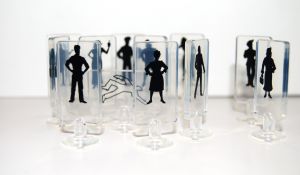 Early in my marketing career, I worked for a large financial company that had a red and green logo. It was at that time that I learned two very important things. First, a red and green logo and brand color palette were extremely limiting creatively. Back in the day, the vast majority of marketing materials were printed. Digital marketing didn’t really exist yet, so most creative marketing initiatives had at least one component that required offset printing. To keep costs down, printing was often limited to one or two colors. When you’re limited to printing marketing materials using only the primary colors in the brand color palette, and those two colors are red and green, it’s very difficult to design a piece that doesn’t look like it fell out of a box of Christmas decorations.
Early in my marketing career, I worked for a large financial company that had a red and green logo. It was at that time that I learned two very important things. First, a red and green logo and brand color palette were extremely limiting creatively. Back in the day, the vast majority of marketing materials were printed. Digital marketing didn’t really exist yet, so most creative marketing initiatives had at least one component that required offset printing. To keep costs down, printing was often limited to one or two colors. When you’re limited to printing marketing materials using only the primary colors in the brand color palette, and those two colors are red and green, it’s very difficult to design a piece that doesn’t look like it fell out of a box of Christmas decorations.
The second thing I learned all those years ago was to avoid red in brand color palettes and logo design. Remember, at the time, most marketing materials were printed. To keep costs down, one or two color printing required the use of halftones. There are many very nice halftones available when you’re working with a bright, Christmas red, but they quickly shift from red to pink. Suffice it to say, pink didn’t communicate the brand image that the financial executives wanted.
Today, creative marketers think differently about the color red. There is far less offset printing being done as print advertising comes a bit closer to death each year. Printed brochures have been replaced with digital versions, and a large amount of direct mail has been replaced with email marketing. In other words, my aversion to red in brand identity color palettes is not as strong as it was 20 years ago. However, it’s still a color that should be used carefully.
The psychology of color plays an important role in brand and marketing communications. Colors evokes feelings in people both consciously and subconsciously. Red is a hot color often associated with anger. In fact, researchers have found that anxiety and aggression increases in test subjects when they’re exposed to the color red. However, depending on the shade of red used, the meaning of the color could change. Its meaning and the emotions it elicits from people also changes depending on what part of the world they’re from. In the United States and most of Europe, red is most often associated with aggression, energy, and danger, but in Turkey and the Ivory Coast, red is associated with death and morning.
Bottom-line, my aversion to red for brand color palettes has decreased significantly over the years, but it’s still a color that I recommend marketers use with caution. Choose the right red to match your brand image while giving you creative flexibility across all media.
For more information about the psychology of the color red in branding, take a look at the infographic from Imagibrand below. I laughed out loud when I saw the reference to red and green in the infographic since I’ve been stuck in that situation before.

Image: Jayesh Nair
 Your brand is probably already represented on Facebook. It probably has a Facebook Page, and one or more people from your company probably publish content on that page and respond to comments published by other users throughout the day. You might even place ads and hold promotions or other marketing campaigns on Facebook. But is your brand truly leveraging the social impact of Facebook?
Your brand is probably already represented on Facebook. It probably has a Facebook Page, and one or more people from your company probably publish content on that page and respond to comments published by other users throughout the day. You might even place ads and hold promotions or other marketing campaigns on Facebook. But is your brand truly leveraging the social impact of Facebook? Corporate social responsibility (CSR) is becoming a larger focus for corporations every day, but actually integrating CSR into your brand strategy (i.e., brand CSR) is something that more companies still need to do. While small companies typically have one person who leads the CSR effort and is responsible for everything CSR-related for the entire organization, larger corporations have a lot more people to consider. The list of stakeholders for a major corporation is very long, and keeping everyone happy is challenging.
Corporate social responsibility (CSR) is becoming a larger focus for corporations every day, but actually integrating CSR into your brand strategy (i.e., brand CSR) is something that more companies still need to do. While small companies typically have one person who leads the CSR effort and is responsible for everything CSR-related for the entire organization, larger corporations have a lot more people to consider. The list of stakeholders for a major corporation is very long, and keeping everyone happy is challenging. Earlier this year, I was cold-called at home by a research agency wanting to know my views on oil companies (their corporate image/reputation/behaviour/media coverage) – and of course, about one in particular.
Earlier this year, I was cold-called at home by a research agency wanting to know my views on oil companies (their corporate image/reputation/behaviour/media coverage) – and of course, about one in particular. Brand blogs are more popular than you might think. According to research from managed WordPress hosting provider
Brand blogs are more popular than you might think. According to research from managed WordPress hosting provider  If you’re marketing a luxury brand to affluent consumers, then you might not want to follow all of the reports and statistics that say traditional media is dying or that investing in television, newspaper, and print ads is a waste of money. According to the
If you’re marketing a luxury brand to affluent consumers, then you might not want to follow all of the reports and statistics that say traditional media is dying or that investing in television, newspaper, and print ads is a waste of money. According to the